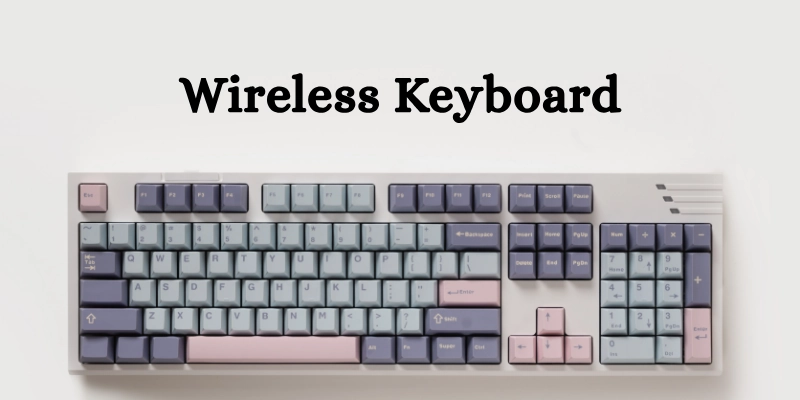Wireless Keyboard Tips for Maximum Comfort and Speed
Published: 8 Oct 2025
Picture a computer keyboard with zero wires! That’s the magic of a wireless keyboard. Unlike regular keyboards, it connects to your computer using Bluetooth or radio frequency (RF) technology, giving you freedom to type from anywhere.
This article explains what a wireless keyboard is, how it works, its parts, types, uses, advantages, and disadvantages.
By the end, you will have a clear idea of a wireless keyboard and how it can make your typing experience easier and more convenient.
What is a Wireless Keyboard?
A wireless keyboard is an input device that lets you type on your computer without using any cables. Unlike traditional keyboards that need a physical connection, a wireless keyboard sends signals wirelessly to your computer using Bluetooth or radio frequency (RF) technology.

In simple terms, a wireless keyboard works just like a normal keyboard. You press keys to type letters, numbers, or commands, but instead of a cable, it communicates wirelessly with your computer. This makes your workspace cleaner and gives you freedom to type from a distance.
Category:
A wireless keyboard is a pointing/typing input device, which means it is part of the devices you use to give instructions or input data into your computer. It belongs to the computer input devices family along with mice, trackpads, and touchscreens.
Appearance:
Most wireless keyboards have the standard rectangular keyboard shape with all the usual keys like letters, numbers, and symbols. Some models also include extra multimedia buttons to control music, volume, or other shortcuts.
They can come in different sizes, from full-sized keyboards to compact or foldable designs, making them suitable for desktops, laptops, or tablets.
History and Invention of the Wireless Keyboard
The wireless keyboard is a modern input device that allows typing without cables. Understanding the history of wireless keyboards helps us see how it evolved from infrared to Bluetooth and RF technology.
Many people also wonder who invented the wireless keyboard, as it was designed for convenience and flexible typing.
- Definition: A keyboard that works without cables using Bluetooth or RF signals.
- History: Developed after wired keyboards and became popular in the 2000s.
- Inventor: Created by technology companies for easier, portable typing.
- Evolution: Early models used infrared; modern ones use Bluetooth or RF.
- Uses: Suitable for desktops, laptops, tablets, and media control.
Parts of a Wireless Keyboard
A wireless keyboard is made up of several important parts that work together to let you type without cables. Here are the main components of a wireless keyboard:
- Keys: Include letters, numbers, symbols, and function keys for typing and shortcuts.
- Battery Compartment: Holds either rechargeable or disposable batteries to power the keyboard.
- Wireless Transmitter: Sends signals to the computer using a USB dongle or Bluetooth connection.
- Circuit Board: Processes the key presses and converts them into signals the computer can understand.
- Indicator Lights: Show the power status, connectivity, and battery level.
How Does a Wireless Keyboard Work?
A wireless keyboard works by sending key press data to your computer using radio frequency (RF) or Bluetooth signals. This removes the need for a physical cable while keeping your typing fast and accurate.
Step-by-Step Working:
Here’s how the working of a wireless keyboard happens:
- Press a Key: The user presses a key on the keyboard.
- Signal Conversion: The circuit inside converts the key press into a digital signal.
- Signal Transmission: The wireless transmitter sends this signal to the receiver connected to the computer.
- Signal Reception: The receiver interprets the signal and forwards it to the computer.
- Display Output: The corresponding text or command appears on the screen.
Example of Working:
You can see the wireless keyboard in action when:
- Typing a document or email.
- Controlling media like music or videos.
- Entering data in software or spreadsheets.
Types of Wireless Keyboards
There are several types of wireless keyboards designed for different needs. Understanding the wireless keyboard types helps you choose the right one for work, gaming, or multimedia use. Each type has unique features and benefits to improve your typing experience.
- Bluetooth Wireless Keyboard:
Connects to your computer or device via Bluetooth, so no USB port is required. Ideal for laptops, tablets, and devices with limited ports. - RF Wireless Keyboard:
Uses a USB dongle and works on radio frequency signals. It is simple to set up and works well from several meters away. - Gaming Wireless Keyboard:
Designed for gamers with high-speed response, programmable keys, and backlit features for gaming in low light. - Multimedia Wireless Keyboard:
Includes extra keys for volume control, media playback, and shortcut functions to make daily tasks easier. - Ergonomic Wireless Keyboard:
Built for comfort to reduce wrist strain and provide a natural typing posture, perfect for long typing sessions.
Uses of Wireless Keyboard
A wireless keyboard has many applications, making it useful in different environments. Understanding the uses of a wireless keyboard can help you choose the right type for your needs.
- Offices:
Wireless keyboards are used for typing documents, data entry, and sending emails, providing a clutter-free workspace. - Education:
Students can type notes and easily control learning software, making study sessions more interactive and efficient. - Gaming:
Gamers benefit from wireless freedom for fast and flexible gameplay, without being limited by cables. - Home Entertainment:
A wireless keyboard can control smart TVs, media centers, or presentations, adding convenience to home entertainment. - Portable Devices:
It works seamlessly with tablets, laptops, and hybrid devices, making it perfect for travel and on-the-go use.
Advantages and Disadvantages
Understanding the benefits and drawbacks of a wireless keyboard helps you decide if it’s the right choice for work, gaming, or home use. This table compares the main advantages and disadvantages for easy reference.
| Pros | Cons |
| No cables → clutter-free workspace | Requires batteries or charging |
| Portable and flexible | Slight input lag compared to wired keyboards |
| Easy to connect to multiple devices | Can face connectivity issues in crowded RF/Bluetooth areas |
| Comfortable typing from a distance | Usually more expensive than wired keyboards |
| Modern features like multimedia keys and backlighting | Some models may be less durable |
Wired vs Wireless Keyboard
The wireless keyboard vs wired keyboard debate helps users understand the difference between wireless and wired keyboards. This comparison highlights their features, pros, and ideal uses.
| Feature | Wireless Keyboard | Wired Keyboard |
| Connection | Bluetooth or RF, no cables | Physical cable connection |
| Portability | Highly portable | Limited by cable length |
| Workspace | Clutter-free | Can be messy with wires |
| Response Time | Slight lag possible | Usually faster response |
| Power Source | Batteries or rechargeable | Powered directly via USB |
| Cost | Usually more expensive | Generally cheaper |
| Durability | May be less durable | Often more durable |
| Setup | Easy with Bluetooth/RF pairing | Plug and play |
Importance of Wireless Keyboard
A wireless keyboard plays a key role in modern computing. Understanding the importance of a wireless keyboard and its use in a wireless keyboard in computer system setup shows why it is a must-have device.
- Reduces Cable Clutter: Eliminates tangled wires and keeps your workspace clean.
- Provides Flexibility in Typing Positions: Type comfortably from different angles and distances.
- Essential for Portable Setups: Perfect for laptops, tablets, and hybrid devices on the go.
- Improves Workspace Organization: Creates a neat and efficient workspace for work, study, or entertainment.
Future of Wireless Keyboards
The future of wireless keyboards looks exciting with advancements in modern wireless keyboard technology. New designs and features aim to improve convenience, performance, and compatibility with modern devices.
- Advanced Connectivity: Integration with Bluetooth 5.0 and low-latency technology for smoother typing and gaming.
- Innovative Designs: Foldable, solar-powered, and ultra-slim keyboards for portability and eco-friendliness.
- Smart Device Integration: Potential use with VR devices, smart TVs, and hybrid workspaces for seamless interaction.
Conclusion
A wireless keyboard lets you type without cables using Bluetooth or RF signals. It comes in different types like Bluetooth, RF, gaming, multimedia, and ergonomic keyboards, suitable for offices, study, gaming, and home use.
With features like portability, ergonomic design, and multimedia keys, a wireless keyboard keeps your workspace neat and makes typing flexible and comfortable.
Wireless keyboards bring freedom from cables to your fingertips, perfect for work, study, or gaming.
FAQs
Find answers to common questions about wireless keyboards below!
A wireless keyboard is a keyboard that lets you type without using cables. It connects to your computer via Bluetooth or radio frequency (RF) signals.
To use a wireless keyboard on a computer, turn it on and connect it via Bluetooth or plug in its USB receiver. Once connected, you can start typing normally like a regular keyboard.
Yes, many wireless keyboards use Bluetooth to connect, but some use RF (radio frequency) with a USB receiver instead. Both types let you type without cables.
A wireless keyboard usually has 104–105 keys for standard layouts, including letters, numbers, function, and special keys. Some compact or specialized models may have fewer keys.
Yes, a wireless keyboard is an input device because it allows you to enter data, text, and commands into a computer without using cables.
It depends on your needs: a wired keyboard is more reliable with faster response and no battery worries, while a wireless keyboard offers portability, flexibility, and a clutter-free workspace.

- Be Respectful
- Stay Relevant
- Stay Positive
- True Feedback
- Encourage Discussion
- Avoid Spamming
- No Fake News
- Don't Copy-Paste
- No Personal Attacks

- Be Respectful
- Stay Relevant
- Stay Positive
- True Feedback
- Encourage Discussion
- Avoid Spamming
- No Fake News
- Don't Copy-Paste
- No Personal Attacks





